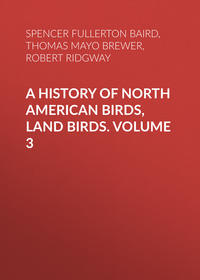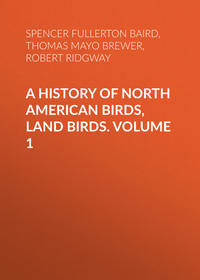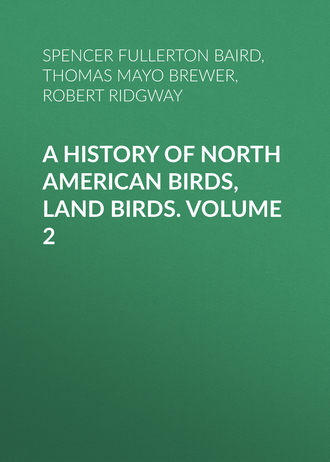 полная версия
полная версияA History of North American Birds, Land Birds. Volume 2
Lastly, in the series from the Pacific coast (S. ruber), we find the whole normal pattern rendered scarcely definable—sometimes entirely obliterated—by the extension of the red, which covers continuously the whole head, neck, and breast; but nearly always the normal pattern may be traced, the feathers of the normally black areas being dusky beneath the surface, and those of the usual white stripes very white for the concealed portion. Usually, in this form, the red of the breast covers only the black pectoral area; but in extreme specimens it reaches back to the middle of the body beneath, and stains the white spots of the back.
With the increase of the red as we proceed westward, there is also a decrease in the amount of white above; thus, in varius the whole back is irregularly spotted with dirty white and black,—the former predominating, the latter most conspicuous as a medial, broken broad stripe,—and the lateral tail-feathers are much variegated by white spots. In nuchalis the back is mostly unbroken glossy-black, with two parallel narrow stripes of white converging at their lower ends; and the lateral tail-feather is almost wholly black, having merely a narrow white border toward the end. S. ruber is most like nuchalis, but has the white still more restricted.
In varius the bill is dark brown, in nuchalis it is deep black, and in ruber wax-brown. In varius the yellow of the lower parts is deepest, in nuchalis just appreciable.
Species and VarietiesA. Wing with a white patch on the middle and greater coverts. Markings along the sides with a longitudinal tendency.
1. S. varius. Back variegated medially with brownish-white; secondaries with transverse rows of white spots.
White and black stripes on side of head sharply defined, as is also the black pectoral crescent. Red confined to isolated patches,—two large ones, one on the crown and one on the throat; when there is more, only a tinge on the auriculars, and a crescent on nape.
Crown sometimes glossy black without a trace of red on the female; no tinge of scarlet on the nape. Red of the throat entirely confined within the broad, continuous black maxillary stripe. Female with the throat wholly white. Hab. Eastern Province North America, south in winter into West Indies, and over whole of Mexico, to Guatemala … var. varius.
Crown always red in adult. A nuchal crescent of scarlet in both sexes. Red of the throat not confined by the black maxillary stripe, which is interrupted by it in the middle, allowing the red to touch the white stripe; a tinge of red on the auriculars. Female always with more or less red on lower part of the throat. Hab. Rocky Mountains and Middle Province of United States … var. nuchalis.
White and black stripes on side of head obsolete, as is also the black pectoral crescent, caused by being overspread by a continuous red wash extending over whole head, neck, and breast.
Whole head, neck, and breast red, with the light and dark stripes of the normal pattern only faintly traceable. Sexes similar. Hab. Pacific Province of United States, north to British Columbia … var. ruber.
2. S. williamsoni. Back unvariegated; secondaries without bands of white spots.
Whole crown and upper parts (except lower part of rump and upper tail-coverts, and wing-patch), a stripe on side of head, a broader one on side of the throat, and the whole jugulum and sides of the breast, unbroken glossy-black; abdomen bright lemon-yellow. Male with a narrow stripe of scarlet on middle of the throat. Female with it white. Young like the adult. Hab. Western Province of United States.
B. Wing without a white patch. Markings on sides regularly transverse.
3. S. thyroideus. Head all round light brown; abdomen bright lemon-yellow; rump and upper tail-coverts white. Entire upper surface, with sides, regularly and continuously barred with black and white, in nearly equal amount; the black bars usually coalesced on the jugulum into a more or less extensive patch. Male with the throat tinged medially with scarlet. Female without any red. Hab. Western Province of United States.

PLATE LI.
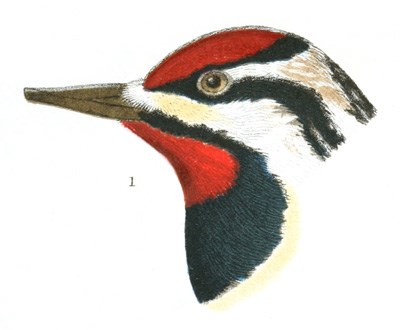
1. Sphyropicus varius. ♂ Pa.
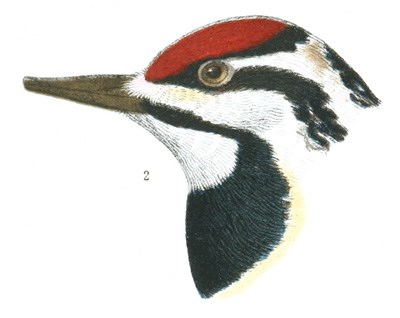
2. Sphyropicus varius. ♀ Pa., 2107.
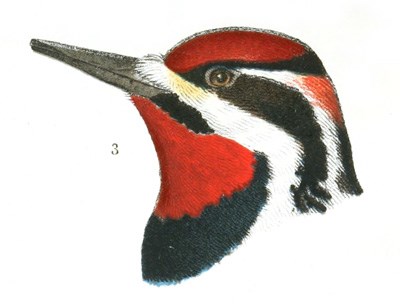
3. Sphyropicus nuchalis. ♂ Wyoming, 10769.
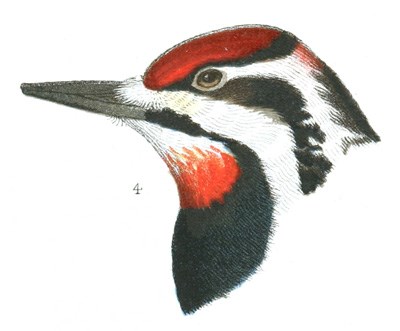
4. Sphyropicus nuchalis. ♀ Wyoming, 10783.
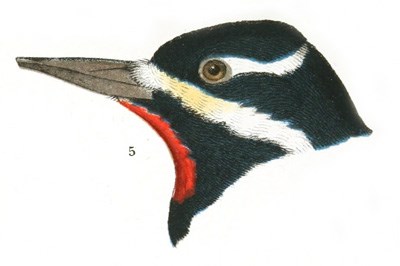
5. Sphyropicus williamsoni. ♀ Cal., 16090.
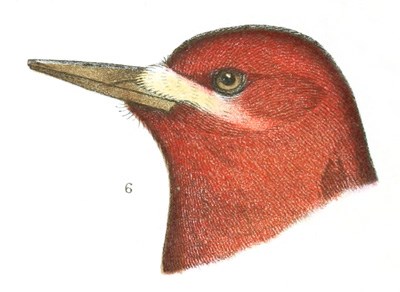
6. Sphyropicus ruber. ♂ Cal., 6038.
Sphyropicus varius, var. varius, BairdTHE YELLOW-BELLIED WOODPECKER
Picus varius, L. Syst. Nat. I, 1766, 176.—Vieillot, Ois. Am. II, 1807, 63, pl. cxviii, cxix.—Wilson, Am. Orn. I, 1808, 147, pl. ix, f. 2.—Wagler, Syst. Av. 1827, No. 16.—Aud. Orn. Biog. II, 1834, 519; V, 537, pl. 190.—Ib. Birds Amer. IV, 1842, 263, pl. cclxvii.—Bon. List, 1838.—Ib. Consp. 1850, 138.—Maxim. Cab. Jour. VI, 1858, 416 (refers to peculiar tongue).—Gosse, Birds Jam. 270 (Jamaica).—Newton, Ibis, 1860, 308 (St. Croix).—Taylor, Ibis, 1860, 119 (Honduras).—Sundevall, Consp. 33.—Gray, Cat. 51. Picus (Dendrocopus) varius, Sw. F. B. A. II, 1831, 309. Pilumnus varius, Bon. Consp. Zygod. Aten. Ital. 1854, 8. Cladoscopus varius, Cab. & Hein. Mus. 80. ? Picus atrothorax, Lesson, Traité d’Ornithologie, I, 1831, 229.—Pucheran, Rev. Zoöl. VII, 1835, 21. (Refers it to Picus varius.) Yellow-bellied Woodpecker, Pennant, Latham. Sphyropicus varius, Baird, Birds N. Am. 1858, 103.—Sclater, P. Z. S. 1859, 367 (Xalapa).—Ib. Catal. 335 (Orizaba).—Ib. Ibis, 1859, 136 (Guatemala).—Ib. 1860, 119 (Honduras).—Cab. Journal, IV, 1856, 102.—Gundlach, Repertorium, I, 1866, 294 (Cuba).—Bryant, Pr. Bost. Soc. 1859 (Bahamas).—Ib. 1865, 91 (Anatomy of tongue.)—Dresser, Ibis, 1865, 468 (breeds in Texas).—Samuels, 96.—Allen, B. E. Fla. 306.
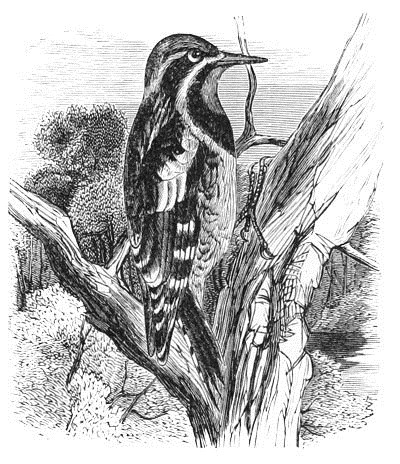
Sphyropicus varius.
Sp. Char. Third quill longest; second a little shorter; first between fourth and fifth considerably shorter. General color above black, much variegated with white. Feathers of the back and rump brownish-white, spotted with black. Crown crimson, bordered by black on the sides of the head and nape. A streak from above the eye, and a broad stripe from the bristles of the bill, passing below the eye, and into the yellowish of the belly, enclosing a black post-ocular one, and a stripe along the edges of the wing-coverts, white. A triangular broad patch of scarlet on the chin, bordered on each side by black stripes from the lower mandible which meet behind, and extend into a large quadrate spot on the breast. Rest of under parts yellowish-white, or yellow, streaked and banded on the sides with black. Inner web of inner tail-feather white, spotted with black. Outer feathers black, edged and spotted with white. Quills spotted with white. Length, 8.25; wing, about 4.75; tail, 3.30. Female with the red of the throat replaced by white. Immature bird without black on the breast, or red on top of the head, as in every intermediate stage to the perfect plumage.
Hab. Atlantic coast to the eastern slopes of the Rocky Mountains; Greenland; West Indies; whole of Mexico, to Guatemala. Localities: ? Oaxaca (Scl. P. Z. S. 1858, 305); Orizaba (Scl. Cat. 335); Xalapa (Scl. 1859, 367); Yucatan (Lawr. Ann. N. Y. Lyc. IX, 205); Guatemala (Scl. Ibis, I, 136); Honduras (Scl. Ibis, II, 119); Cuba (Cab. J. IV, 102); (Gundl. Repert. I, 1866, 294); Bahamas (Bryant, Pr. Bost. Soc. VII, 1859; Ib. 1867, 65); Jamaica (Gosse, B. Jam. 270); St. Croix (Scl. Ibis, II, 308); E. Texas (Dresser, Ibis, 1865, 468; breeds).
There is an occasional variation in the markings of the tail-feathers. Thus, in No. 782, from Carlisle, the innermost one is entirely black, while in 4,631, from the Upper Missouri, the outer web of the same feather has nearly, and in 2,107, from Carlisle, it has quite, as much white as the inner web. The outer webs do not appear to vary so much.
Specimens from the whole of Mexico, including even the west coast, are referrible to varius; they are probably winter migrants from the eastern United States.
A female, from Washington, D. C. (No. 12,260, C. Drexler), has the lower half of the throat much mixed with red, as in var. nuchalis; but there is no trace of this color on the nape. A male from Carlisle (No. 12,071, W. M. Baird) has the nape distinctly tinged with red, as in nuchalis, but the black malar stripe is uninterrupted. Similar specimens have been taken in New England, by Messrs. Brewster and Henshaw.
Many females occur with the entire pileum glossy-black, there being no trace of red, though there are sometimes specks of white.
Habits. The Yellow-bellied Woodpecker is found throughout the United States, from the Gulf of Mexico on the south and the Atlantic on the east to the Rocky Mountains, and is met with as far to the north as the 61st parallel of latitude. Sir John Richardson found it common in the fur countries, being the only Woodpecker that visits those regions in flocks. He observed the Yellow-bellied Woodpecker on the north shore of Lake Huron on the 14th of April, in 1825, and in 1827 it made its first appearance for the season, on the plains of the Saskatchewan, on the 14th of May. Swainson received specimens of this Woodpecker from Mexico. De la Sagra and Dr. Gundlach both give it in their list of Cuban birds, though not as breeding on that island. Gosse obtained several specimens in the months of December, January, and February, in Jamaica, where he regarded it as only a winter migrant from the northern continent. It is not given by the Newtons among the birds of St. Croix, but appears in Sclater’s list of the birds of Central America, on the authority of Mr. George M. Skinner. Two specimens have been taken in Greenland.
Wilson, in his account of its breeding habits, speaks of it as a resident bird from Cayenne to Hudson’s Bay, as being common in the States of Kentucky and Ohio, and as having been found in the neighborhood of St. Louis. He describes the habits of this species as similar to those of the Hairy and Downy Woodpeckers, with which it generally associates. The only nest of this bird which Wilson ever met with was in the body of an old pear-tree, about ten or eleven feet from the ground. The hole was almost exactly circular, small for the size of the bird, so that it crept in and out with difficulty; but the excavation suddenly widened, descending by a small angle, and then running downward about fifteen inches. On the smooth solid wood lay four white eggs. This was about the 25th of May.
Mr. Audubon, on the other hand, speaks of this species as returning to Louisiana and the other Southern States only about the beginning of October, remaining there during the winter, and again taking its departure before the beginning of April, after which period he never observed it in those districts. A few only, according to the same authority, breed in Kentucky, but the greater number migrate to the more northern parts of the Union. He describes it, in its habits, as preferring the interior of the forest during the spring and summer, seldom showing itself near the habitation of man at those seasons. It generally, he adds, bores its nest at a considerable height, and usually in the trunk of an undecayed tree, immediately beneath a large branch, and on its southern side. The hole is worked out by the male as well as the female, in the manner followed by the other species, and to the depth of from fifteen to twenty-four inches. The aperture is just large enough to admit the birds, but the whole widens gradually towards the bottom, where it is large and roomy. The eggs, which are from four to six, and pure white, with a slight blush, are deposited on the chips without any nest. The young seldom leave the hole until they are fully fledged.
Mr. Audubon elsewhere speaks of having found this species extremely abundant in the upper parts of the State of Maine and in the Provinces of Nova Scotia and New Brunswick; but he saw none in Newfoundland or Labrador.
For my specimens of the eggs of this species and valuable information as to its habits, I am indebted to Mr. Charles S. Paine, of East Bethel, Vt., in which State it seems to be quite abundant. In a letter written in the summer of 1860, he furnishes the results of his observations relative to their habits, so far as they have fallen under his notice.
The Yellow-bellied Woodpeckers reach the central and northern parts of that State about the 10th of April. They soon make their presence known there by their loud and continued drumming, rather than tapping, on the trunks and larger branches of decaying trees. Of this drumming they seem to be peculiarly fond, especially where they can produce a loud ringing sound. Sometimes, when Mr. Paine had been engaged in the process of preparing maple sugar, he had left a few empty wooden buckets hanging on the branches of trees, until needed for use. Upon these the bird will drum, apparently with the greatest delight. At times they would experiment upon the tin pails, but, being unable to obtain good standing-ground, they did not follow it up. On such occasions their drumming did not appear to be done in the pursuit of worms or food, but was very evidently for their own entertainment, or in a spirit of rivalry one with another, as if seeking to please their mates. When two male birds meet, they pursue each other through the woods with great clamor. They have a loud, distinct, and lively note, but their favorite music appears to be this drumming. They mate and commence the excavation of their nests the last week in April. Their eggs are usually deposited, in this section, somewhere between the 20th of May and the first of June. The excavations for their nests are usually made in the tops of large decaying trees. He adds that he found four or five of these nests that year. The eggs of one of these he was able to obtain without much trouble, the others had hatched. When the young leave their nests they usually keep together, and often four or five may be seen playing about the bark of the same tree while waiting for their parents to bring them their food.
This species is far more abundant at the West than it is in the New England States. In the States of Rhode Island, Connecticut, and Massachusetts it is very rarely met with. It is commonly known as the Sap-Sucker, and much better deserves that name than do other species to which this term is also applied. Owing to the peculiar formation of its tongue and the muscles connected with it, it feeds less readily upon insects, and they form a smaller proportion of its food. In the spring of the year these birds prey largely upon the inner bark of trees, and where they exist in great numbers often do a great deal of mischief. In April, 1868, I visited gardens in Racine, in company with Dr. Hoy, where these Woodpeckers had every successive spring committed their ravages, and was eyewitness to their performance. Their punctures were unlike those of the pubescens, being much deeper, penetrating the inner bark, and, being repeated in close proximity, becomes entirely stripped off after a while, often resulting in the girdling and complete destruction of the tree. In one garden of some considerable size, all the mountain-ash and white-pine trees had thus been killed. In prairie countries, where trees are a deficiency and their cultivation both important and attended with difficulty, these birds prove a great pest, and in a few hours may destroy the labor of many years. These habits, so well known to most of our Western farmers, appear to have entirely escaped the notice of our older ornithologists.
Mr. Dresser found these birds near San Antonio at all seasons of the year, but rather rare. He shot a couple near the Medina River, and Dr. Heermann also procured the eggs in that neighborhood.
Mr. Ridgway says that in Southern Illinois this Woodpecker is only a winter resident, coming from the north in September or October, and departing in April. It is the only one of the eight species of Woodpeckers of that section which does not breed there, and also the only one which is not resident.
Specimens of its eggs from Vermont measure .95 by .70 of an inch. They are of an oval shape, a little less rounded at one end than at the other.
Sphyropicus varius, var. nuchalis, BairdTHE RED-NAPED WOODPECKERSphyropicus varius, var. nuchalis, Baird, Birds N. Am. 1858, 103, pl. xxxv, figs. 1, 2. Sphyropicus nuchalis, Baird, Ib. 921.—Coues, Pr. A. N. Sc. 1866, 53.—Cooper, Pr. Cal. Ac. 1861, 122.—Cass. P. A. N. S. 1863, 204.—Cooper, Orn. Cal. 1, 1870, 390. Picus varius occidentalis, Sundevall, Consp. Pic. 1866, 34. Cladoscopus nuchalis, Cab. & Hein. 82.
Sp. Char. Markings, generally, as in S. varius. A red nuchal crescent. Belly yellowish-white. The red of the throat extending over and obliterating the black stripe from the lower mandible, except on the side of the jaw. Post-ocular black patch tinged with red. Secondaries with little or no white on outer webs. Tail-feathers black, scarcely varied; the innermost with inner web, as in varius. Female similar, but with the chin white; the throat red, bordered, as in male, by a black stripe from the bill to the black pectoral patch. Length, 8.00; wing, 5.00; tail, 3.50.
Hab. Middle Province of United States. Localities: Fort Mohave (Cooper, Pr. Cal. Ac. 1861, 122); W. Arizona (Coues, P. A. N. S. 1866, 53).
This bird, first indicated as a simple variety of S. varius, is yet as decidedly distinct and constant in its markings as a large number of what are considered to be valid species. The principal differences from varius have been mentioned above: they consist mainly in the greater development of red, as seen in wider throat-patch; nuchal crescent; tinge on cheek; a greater amount of black, shown in unspotted outer webs of secondaries and blacker tail, and in the paler colors below. The most striking peculiarity is in the half-red throat of the female, which is entirely white in varius. The light markings of the back are more distinctly arranged in two lines enclosing a median of black, which show no concealed white spots as in varius. The breast is much paler, only slightly tinged with yellow, instead of the rich color to which S. varius owes its trivial name.
Young birds vary in color to the same excessive degree as in varius.
Habits. This form, closely allied to the varius, was at first known only from the southern Rocky Mountains. Afterwards a large number of specimens were obtained by Mr. C. Drexler at Fort Bridger, in Utah.
Dr. Cooper procured a female specimen of this species at Fort Mohave, on the 20th of February, 1861, which had probably wandered in a storm from the mountains, and which was the only one he met with. Dr. Heermann states, also, that they were not rare at Fort Yuma. Dr. Cooper’s bird was silent and inactive, as if exhausted by a long flight. He also saw these birds rather common as he crossed the mountains near latitude 48° in September, 1860, and noticed a great similarity in their habits to those of the S. varius. They chiefly frequented small deciduous trees, fed in the usual manner of other Woodpeckers, and had also a shrill, unvaried call or note of alarm.
Dr. Coues found this Woodpecker an abundant and a permanent resident in Arizona. Its distinctness as a species he did not question. Everywhere common, it seemed to prefer live cottonwood-trees and willows. Two specimens of this race have been taken in New England,—one in New Hampshire by Mr. William Brewster, the other in Cambridge by Mr. Henshaw.
The Red-naped Woodpecker was found by Mr. Ridgway to be one of the most abundant and characteristic species of the Wahsatch and Uintah Mountains. It was also found, in greater or less numbers, throughout the Great Basin, in the region of his route, and was even obtained on the eastern Sierra Nevada, where, however, only one specimen was seen. Its favorite resort, during summer, was the aspen groves in the mountains, at an altitude averaging about seven thousand feet; and even when pine woods were near the aspens were invariably chosen as nesting-places. Its excavations were always in living trees, and the abandoned ones were taken possession of by Purple Martins and White-bellied Swallows (Progne subis and Tachycineta bicolor) as nesting-places. In winter it was found among the cottonwoods and willows of the river valleys. Its habits, manners, and notes are described as almost perfectly similar to those of S. varius.
Sphyropicus varius, var. ruber, BairdTHE RED-BREASTED WOODPECKERPicus ruber, Gm. Syst. Nat. I, 1788, 429.—Wagler, Syst. Av. 1827, No. 151.—Aud. Orn. Biog. V, 1839, 179, pl. ccccxvi.—Ib. Birds Amer. IV, 1842, 261, pl. cclxvi.—Sundevall, Consp. Pic. 32. Melanerpes ruber, Rich. List, Pr. Br. Assoc. for 1835.—Bonap. List, 1838.—Ib. Consp. 1850, 115. Pilumnus ruber, Bon. Consp. Zyg. Aten. Ital. 1854, 8. Picus flaviventris, Vieillot, Ois. Am. Sept. II, 1807, 67. Sphyropicus ruber, Baird, Birds N. Am. 1858, 104.—Cooper & Suckley, 160.—Gray, Cat. 51.—Cooper, Orn. Cal. 1, 1870, 392. Cladoscopus ruber, Cab. & Hein. Mus. Hein. IV, 1863, 82.
Sp. Char. Fourth quill longest; third intermediate between fourth and fifth. Bill brown wax-color. Head and neck all round, and breast, carmine-red. Above black, central line of back from nape to rump spotted with whitish; rump, wing-coverts, and inner web of the inner tail-feathers white, the latter with a series of round black spots. Belly sulphur-yellow, streaked with brown on the sides. Narrow space around and a little in front of the eye black. A yellowish stripe from the nostrils, a short distance below and behind the eye. Length, about 8.50; wing, 5.00; tail, 3.40. Sexes similar.
Hab. Pacific slopes of the United States.
As stated in the remarks before the synopsis on page 1133, there is every reason for considering this as merely a geographical race of a species, of which nuchalis and varius are the other forms. The differences from varius consist merely in an excessive amount of red, this obliterating the normal pattern of the cephalic portions; and in an increased amount of black, or a manifestation of the melanistic tendency so often distinguishing birds of the Pacific coast region from their eastern co-specific representatives.
S. nuchalis is exactly intermediate in all respects between S. ruber and S. varius,—the extremes,—while each of the latter is connected with the intermediate race by specimens combining the characters of both races.
Habits. The geographical distribution of this form seems to be restricted to the Pacific coast region.
Dr. Cooper only met with these birds three times in Washington Territory. This was in spring and fall. He speaks of them as being very shy, silent, and retiring, remaining among the dense tops of the dark forest trees. Whether it resides and breeds in the Territory he had no means of determining. Dr. Suckley saw but one specimen, and regarded it as confined, for the most part, to the close vicinity of the coast.
Mr. Audubon assigns to it the same distribution, but is only able to give the information in regard to its habits which he derived from the observations of Mr. Nuttall, which, however, do not correspond with those of Dr. Cooper. Mr. Nuttall states that this species, seen in the forests of the Columbia and the Blue Mountains, has most of the habits of the common Red-headed species. He concedes that it is less familiar, and that it keeps generally among the tall fir-trees, in the dead trunks of which it burrows out a hole for a nest, sometimes at a great elevation. On approaching one that was feeding its young in one of these situations, it uttered a loud reverberating t’rr, and seemed angry and solicitous at his approach. He adds that this species also inhabits California, as well as the northwest coast up to Nootka, and that it is found eastward as far as the central chain of the Rocky Mountains. An egg taken from a nest which contained four was 1.25 in length and .75 of an inch in breadth. It was smooth, equally rounded at both ends, though somewhat elongated, and pure white.




